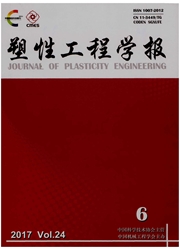

 中文摘要:
中文摘要:
以ABAQUS仿真软件为平台,建立芯模自转与旋轮公转的两种筒形件正旋有限元模型,介绍了2种不同模型分析边界条件的设定。采用Python语言开发子程序提取模拟结果的三维坐标值,然后导入逆向工程软件Geomagic中还原为云图的方法,分析了2种模型模拟结果的贴模性、壁厚均匀性、径向应力应变,并比较了2种模型的计算时间。结果表明:芯模自转模型的模拟计算时间明显小于旋轮公转模型,芯模自转模型的贴模性与壁厚均匀性较旋轮公转模型更均匀,因此芯模自转模型较旋轮公转模型更适合于筒形件流动旋压的模拟分析。
 英文摘要:
英文摘要:
In this study a finite element (FE) model of mandrel autorotation and an FE model of roller-revolution for for-ward tube flow forming based on ABAQUS/Explicit code were created. Treatment of boundary condition for two models were presented in details. Three-dimensional coordinate values were extracted from simulation results, and then the values were imported into reverse-engineering software Geomagic using the subroutine developed by Python language. It is shown that simula- tion time by using the mandrel-autorotation model is significantly less than that by using roller-revolution model, the thickness and die fittingness distribute more uniform by using the mandrel autorotation model than those by using roller-revolution model. Therefore, the mandrel-autorotation model is the one suitable for simulation of the tube spinning.
 同期刊论文项目
同期刊论文项目
 同项目期刊论文
同项目期刊论文
 期刊信息
期刊信息
